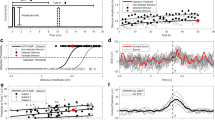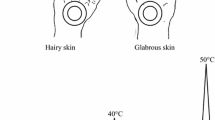Abstract
The effects of stages in the estrous cycle on electrical pain thresholds were studied in white rats in conditions of chronic measurement. On recording day 3, females in the diestrus and estrus stages showed sharp increases in shudder and paw-shuffling thresholds. Females in proestrus and metestrus showed no change in thresholds as compared with those in the first days of recording. Starting from day 7, there were progressive decreases in electrical pain thresholds regardless of the stage of the estrous cycle. Data for all animals showed that regular measurement of pain thresholds induces a smooth two-fold increase in body resistance from day 1 to day 7. This was followed by a sharp drop on day 8, with parallel decreases in body resistance and electrical pain thresholds. Thus, chronic measurement of electrical pain thresholds and body resistance changed in a complex fashion, and threshold values depended on the stage of the estrous cycle.
Similar content being viewed by others
REFERENCES
I. Ya. Ashkinazi, I. A. Ishinova, and E. M. Tsirul'nikov, “Cutaneous pain sensitivity in chronic psychoemotional stress in humans,” Neirofiziologiya, 24, No. 5, 535–538 (1992).
A.S. Batuev, “The principle of the dominant in the integrative activity of the brain,” in: The Physiology of Behavior. Neurophysiological Characteristics [in Russian], Nauka, Leningrad (1986), pp. 201–268.
E.P. Vinogradova, I. N. Zaichenko, and D. A. Zhukov, “The effects of stress on anxiety levels in female white rats at different stages of the estrus cycle,” Zh. Vyssh. Nerv. Deyat., 46, No. 4, 769–772 (1996).
J. Tapperman and H. Tapperman, Metabolic Physiology and the Endocrine System [Russian translation], Mir, Moscow (1989).
A.A. Ukhtomskii, The Dominant [in Russian], Nauka, Leningrad (1966).
D.A. Bereiter and D. J. Barker, “Hormone-induced enlargement of receptive fields in trigeminal mechanoreceptive neurons. I. Time course, hormone, sex, and modality specificity,” Brain Res., 184, No. 2, 395–410 (1990).
D. Bitran, R. H. Purdy, and C. K. Kellogy, “Anxiolytic effects of progesterone are associated with increases in cortical allopregnalone and GABAa receptor function,” Pharmacol. Biochem. Behav., 45, No. 3, 423–428 (1993).
R.L. Butcher, W. E. Collins, and N. W. Fugo, “Plasma concentration of LH, FSH, prolactin, progesterone, and estradiol-17βthrough the 4-day estrus cycle of the rat,” Endocrinology, 94, No. 2, 1704–1708 (1974).
M.P. Carey, A. E. Billing, and J. P. Fry, “Fluctuations in responses to diazepam during the oestrus cycle in the mouse,” Pharmacol. Biochem. Behav., 41, No. 1, 719–725 (1992).
S.N. Clark and K. P. Osenkopp, “Taste reaction responses in rats: influence of sex and the estrous cycle,” Amer. J. Physiol., 274, No. 2, 718–725 (1998).
P. Deurenbeerg, H. E. Smith, and C. S. Kusters, “Is the bioelectrical impedance method suitable for epidemiological studies?” Eur. J. Clin. Nutr., 43, No. 9, 647–651 (1989).
G. Diaz-Veliz, V. Soto, N. Dussaubat, and S. Mora, “Influence of the estrous cycle ovarioectomy and estradiol replacement upon acquisition of conditioned avoidance response in rats,” Physiol. Behav., 46, No. 3, 387–401 (1989).
H. E. Edwards, W. M. Burnham, A. Mendonca, D. A. Bowlby, and N. J. MacLusky, “Steroid hormones affect limbic afterdischarge thresholds and kindling rates in adult female rats,” Brain Res., 838, No. 1-2, 136–150 (1999).
R. Gudivaka, D. A. Schoeller, R. F. Kushner, and M. J. Bolt, “Single-and multifrequency models for bioelectrical impedance analysis of body water compartments,” J. Appl. Physiol., 87, No. 3, 1987–1096 (1999).
C. Hicks, A. P. Schinckel, J. C. Forrest, J. T. Akridge, J. R. Wanger, and W. Chen, “Biases associated with genotype and sex in prediction of fat-free lean mass and carcass value in hogs,” J. Anim. Sci., 76, No. 9, 2221–2234 (1998).
M. Kavliers and J. P. Weibe, “Analgetic effects of progesterone metabolite, 3-alpha-hydroxy-5-alpha-pregnen-20-one, and possible modes of action in mice,” Brain Res., 415, No. 2, 393–399 (1987).
M. Kavliers, J. P. Weibe, and L. A. Galea, “Reduction of predator odor-induced anxiety in mice by the neurosteroid 3-alpha-hydroxy-5-alpha-pregnen-20-one (3 alpha HP),” Brain Res., 643, No. 1-2, 325–332 (1994).
B. J. Zarowitz, “Bioelectrical impedance analysis measurements for drug pharmacokinetics,” Amer. J. Clin. Nutr., 64, No. 3, 519–525 (1996).
Author information
Authors and Affiliations
Rights and permissions
About this article
Cite this article
Vinogradova, E.P., Zhukov, D.A. & Batuev, A.S. The Effects of Stages of the Estrous Cycle on Pain Thresholds in Female White Rats. Neurosci Behav Physiol 33, 269–272 (2003). https://doi.org/10.1023/A:1022155432262
Issue Date:
DOI: https://doi.org/10.1023/A:1022155432262




